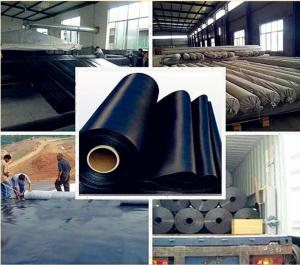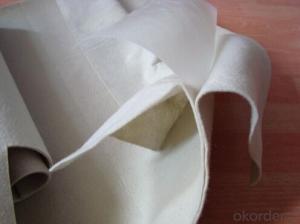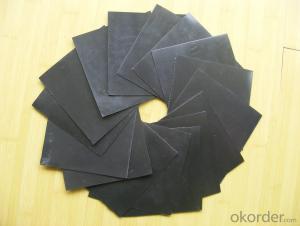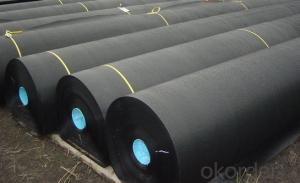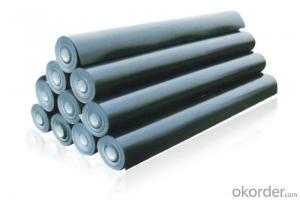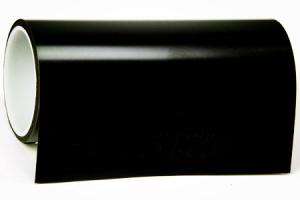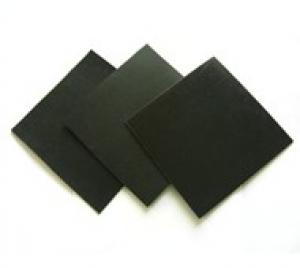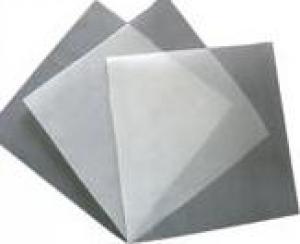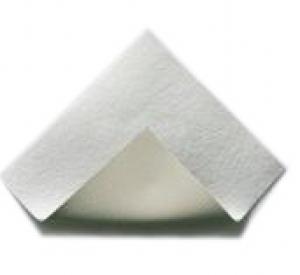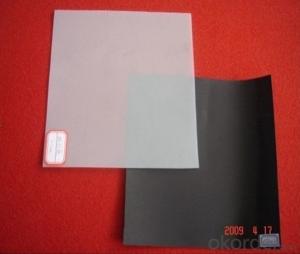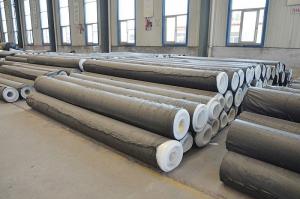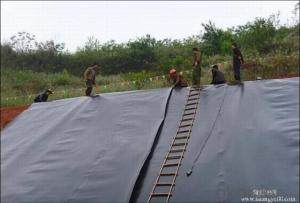Geomembrane
- Loading Port:
- China Main Port
- Payment Terms:
- TT OR LC
- Min Order Qty:
- -
- Supply Capability:
- -
OKorder Service Pledge
Quality Product, Order Online Tracking, Timely Delivery
OKorder Financial Service
Credit Rating, Credit Services, Credit Purchasing
You Might Also Like
Product Overview
Geomembrane is composited with geocloth、polyethylene film and polyvinylchloride film.
It has advantages of surfacedrainage、high strength、corrosion-proof、high tearing resistance、seepage-proofing,and be widely used in the anti-seepagetreatment of the dike、railway、highway and drainage ditch, as well as in the landfill、tunnel seepage control and waterproof treatment.
Product Features
| High cost performance |
| Perfect after-sales service |
| Flexible and durable |
| Easy to transport |
| Fast delivery |
Product Specification
| Width | ≤6m |
Membrane material thickness | 0.2mm-0.8mm |
| Mass per unit | 100-800g/㎡ |
- Q:What are the considerations for geomembrane installations in areas with high seismic activity?
- When installing geomembranes in areas with high seismic activity, several considerations should be taken into account. Firstly, it is essential to choose a geomembrane material with high tensile strength and flexibility to withstand the ground movements caused by earthquakes. Additionally, the geomembrane should have excellent puncture resistance and tear strength to prevent any damage during seismic events. Another important consideration is the anchoring system. Geomembranes should be adequately anchored to prevent excessive movement or uplift during seismic activity. This may involve using anchor trenches, batten bar systems, or other securing methods that can withstand the forces generated by earthquakes. Furthermore, proper site characterization and geotechnical investigations are crucial in understanding the soil conditions and potential liquefaction risks in the area. This information helps in designing appropriate foundation systems and selecting the most suitable geomembrane installation techniques. Overall, the considerations for geomembrane installations in areas with high seismic activity include choosing the right material, ensuring proper anchoring, and conducting thorough site investigations to mitigate potential risks associated with earthquakes.
- Q:What are the characteristics of membrane touch switch?
- Membrane switch has many advantages: It is resistant to water, dust, oil and harmful gas erosion, and is stable and reliable in properties. It has small volume, long service life, and convenient installation. Its panel can be washed without damage of characters on it. It also has rich color and elegant appearance. Your product will obtain more distinct features of the time by using the membrane switch. Main types of the membrane switch: With rigid or flexible printed circuit board as substrate, the membrane switch panel is made with plastic (polycarbonate, polyester, etc.) faceplate with colored decorative patterns printed on it. It is installed with keys with hand feeling or not. It is a kind of electronic component integrating switch function with decorative function, and also has a new human-machine interface. Its switching circuit and connection mode of the complete appliance can be finished by welding or plug-in. It is good.
- Q:What are the temperature resistance properties of geomembranes?
- Geomembranes have excellent temperature resistance properties, as they are specifically designed to withstand extreme temperatures. They are capable of maintaining their integrity and functionality in both high and low temperature environments, making them suitable for various applications such as landfills, mining, and agriculture.
- Q:What's the origin of leakproof geomembrane?
- In my opinion, waterproofing is that the water should be kept out, such as embankments, dams, their waterproof controls mainly prevent outside water from sluicing and soaking; while anti-seepage mainly prevents internal water flowing out, such as impervious barriers of landfills, the purpose of which is to prevent sewage and hazardous substances from polluting the land.
- Q:How to remove the glass film
- Tear off the hair when it is heated by the hair drier.
- Q:Is lectric heating film electric heater electricity-saving
- It depends on two factors, one is the electric heat conversion efficiency, the two is the power. The high the electric heating conversion efficiency, the less electricity it consumes. Well, if we understand this we can analyze whether our household appliances consumes electricity. Power is a fixed value, which is fixed before we buy. For example, we buy a electrothermal film heater whose power is 2000W. This means that the heater consumes 2 kwh of electricity per hour, which is 2 degrees, if it is 1500W, that is 1.5 degrees Electric per hour. The electrothermal conversion efficiency is to consume things unease to know, but we can generally analyze like so: The process of heating is a process that transfers electric energy into heat energy, so we would hope that electrothermal conversion efficiency be higher if we want to get maximum heat. According to the law of conservation of energy, the greatest possibility is 100% conversion. But in fact, the conversion of electric energy into heat energy also includes the conversion into light, (such as small solar heating, which is also luminous in the the moment of heating, a lot of power is converted into the energy we don't need, so the conversion efficiency is low, magnetic energy and other energy. Therefore, in general, the electrothermal conversion efficiency of most heating body is almost the same in the current market, the transfer efficiency of heat body that is not luminous is higher than those giving out lights.
- Q:How do geomembranes handle settlement?
- Geomembranes handle settlement by being flexible and able to conform to changes in the underlying terrain. They can stretch and move with the ground, minimizing the risk of tearing or damage. Additionally, geomembranes are often designed with reinforcement materials to enhance their resistance to settlement. Overall, geomembranes are engineered to accommodate settlement and ensure long-term stability and performance.
- Q:What are the potential risks associated with geomembrane installation and use?
- There are several potential risks associated with geomembrane installation and use. One major risk is improper installation, which can lead to leaks or tears in the geomembrane, compromising its effectiveness as a barrier. This can result in environmental contamination or structural damage to the project. Additionally, if the geomembrane is not properly anchored or secured, it can be displaced by strong winds or other external factors, leading to failure of the containment system. Another risk is the potential for degradation over time due to exposure to UV radiation, chemicals, or extreme temperatures, which can weaken the geomembrane and reduce its lifespan. Regular inspection and maintenance are necessary to identify and address any potential risks to ensure the proper functioning of geomembranes.
- Q:How do geomembranes perform in high temperature environments?
- Geomembranes perform well in high temperature environments due to their excellent heat resistance properties. They are specifically designed to withstand elevated temperatures without any significant deterioration in their performance. The material used in geomembranes, such as HDPE (high-density polyethylene), has a high melting point and can withstand temperatures up to 120°C (248°F) or even higher. This allows them to be used in various applications, including mining, oil and gas, and waste management, where high temperatures may be encountered. Moreover, geomembranes also provide excellent resistance to UV radiation, chemical exposure, and mechanical stress, further enhancing their performance in high temperature environments.
- Q:Are geomembranes suitable for use in biogas production?
- Yes, geomembranes are suitable for use in biogas production. They are commonly used as liners in anaerobic digesters and biogas storage systems to prevent leakage of the biogas and protect against contamination. Geomembranes provide an effective barrier to maintain the integrity of the biogas production process.
1. Manufacturer Overview |
|
|---|---|
| Location | |
| Year Established | |
| Annual Output Value | |
| Main Markets | |
| Company Certifications | |
2. Manufacturer Certificates |
|
|---|---|
| a) Certification Name | |
| Range | |
| Reference | |
| Validity Period | |
3. Manufacturer Capability |
|
|---|---|
| a)Trade Capacity | |
| Nearest Port | |
| Export Percentage | |
| No.of Employees in Trade Department | |
| Language Spoken: | |
| b)Factory Information | |
| Factory Size: | |
| No. of Production Lines | |
| Contract Manufacturing | |
| Product Price Range | |
Send your message to us
Geomembrane
- Loading Port:
- China Main Port
- Payment Terms:
- TT OR LC
- Min Order Qty:
- -
- Supply Capability:
- -
OKorder Service Pledge
Quality Product, Order Online Tracking, Timely Delivery
OKorder Financial Service
Credit Rating, Credit Services, Credit Purchasing
Similar products
New products
Hot products
Hot Searches
Related keywords








